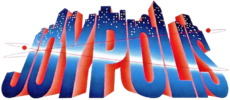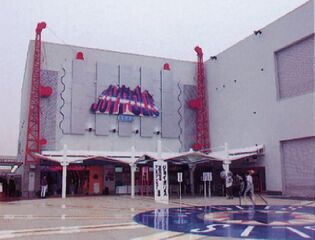Yokohama Joypolis
From Sega Retro

|

|
| Yokohama Joypolis |
|---|
| Location: 神奈川県横浜市中区新山下1丁目14番18号, Japan |
| Opened: 1994-07-20[1] |
| Closed: 2001-02-28[1] |
Yokohama Joypolis (横浜ジョイポリス), later Joypolis H. Factory Yokohama (ジョイポリスH.FACTORY横浜), was the first Joypolis indoor theme park opened by Sega. Alongside the earlier Osaka ATC Galbo, the park was one of the original two locations opened under the Amusement Theme Park concept in 1994, becoming the company's flagship amusement venue during the mid 1990s. It has since been closed permanently and demolished.
Contents
History
Development
As far back as the late 1960s, Sega had been opening and maintaining numerous "game centres" in Japan. Operations of these were generally small-scale, however by the mid 80s, several companies in the amusement industry were establishing branded chain stores and re-evaluating long-term ambitions in the field. Spearheaded by Hayao Nakayama, Sega of Japan's amusement divisions began working towards opening increasingly bigger venues that would further assert their position in the amusement industry; alongside this, R&D teams started developing technologically advanced interactive attractions for them. Early work involving these was undertaken with the short-lived En-Joint concept in the early 90s, and the creation of the prolific Sega World game centres and entertainment venues.
Direct competition soon came from Namco, with the launch of their Wonder Eggs theme park in February 1992,[2] as well as Taito's large Cannonball City facility the following year.[3] Whilst also focused on the development of new large inner-city game centres that included Roppongi GiGO, Sega opened the smaller Sega World Hakkeijima Carnival House centre on the grounds of the Hakkeijima Sea Paradise theme park in Yokohama during May 1993. Alongside coin-operated arcade machines, the centre contained a small number of mid-size attractions developed by the company, most significantly an AS-1 unit and 8-player Virtua Formula, as well as the capacity for events. In the following months, both attractions were deployed at new overseas Sega centres including Sega World Bournemouth and Sega VirtuaLand, as with plans in place by this point to create theme park venues in Japan and across the rest of the world.[4]
By this time, plans were already underway for a larger location elsewhere in Yokohama. In the months leading up to its launch, the secondary Galbo scheme also debuted with Osaka ATC Galbo in April 1994, the first venue to be officially categorised under the "Amusement Theme Park" or "ATP" moniker - this concept was created to describe large indoor theme park-type venues with multiple attractions of various sizes, as well as added amenites including fast food outlets and gift shops. With the ATP concept established and running, construction began on what would be the original Joypolis park.
Opening
Yokohama Joypolis was opened to the public on 20 July 1994. Located on a 11,946m² plot of land, its site encompassed a main 8,250m² indoor theme park building ran by Sega, three additional ones housing other businesses, and two parking lots. At launch, the main building was dedicated to the park's seven major attractions located throughout most of the floor space, and over 200 coin-operated arcade machines[5], many of which were stationed on a sub-level between the first and second floors.
Alongside several pre-existing attractions that had been previously installed at smaller venues, Mad Bazooka, VR-1, and Rail Chase: The Ride made their public debuts at the park on opening day - due to their large sizes, the construction of all three would not have been feasible at any other location up to that point in time. Other features of the park included its roster of coin-operated arcade machines, a SegaSonic & Tails souvenir shop, and fast food restaurant Cafe Blanca, supporting several other facilities situated outside of the park building but on the same premises which also served food and drink, including two McDonalds outlets.
Initial reviews of Yokohama Joypolis appear to have been generally positive, praising the technological advancements of VR-1 in particular. In the following months, Sega took advantage of the venue's large size and capacity for organised events to hold numerous examples of them, including notable Virtua Fighter and Sega Rally Championship tournaments; these officially-held events were communicated through issues of magazines like SegaJack which were handed out inside of the park, and would become a key aspect of subsequent Joypolis parks.
Demise
Although initial returns are thought to have been sufficient, with promotional material from Sega claiming 1.75 million visitors came to the centre in its first year of operation, these numbers soon fell. One factor attributed to this was the fact that the park, situated away from the central district of Yokohama, was a fifteen-minute walk from the nearest subway station, something which was later rectified in 2004.[6]
After a period of downtime, Yokohama Joypolis reopened the following year on 25 July, undergoing a partial refurbishment in the process. Under the new name of Joypolis H. Factory Yokohama, its operations were now assisted by media personality and businessman Hiromi Konzo, who at the time was developing a number of sports-themed leisure centres. A small number of new leisure attractions were added, supporting the main Sega-developed examples in place since 1994, which had since received software and theming updates.
The centre closed permanently at the end of February 2001, in the midst of a restructuring at Sega which led to several other Joypolis venues going defunct and a scrapping of the plans for a further 50 in Japan. Whilst a number of its auxiliary facilities continued trading, the space the main building formerly occupied subsequently became warehouse storage, and its grounds have more recently been demolished and redeveloped for a block of flats.
Story
Yokohama Joypolis was themed around a conceptual story involving a fictional professor named "Dr. Chrono" and the "B.U.R.P." (Basic Universal Reflector Prism), a device which, in its physical form, involved the escalators linking the floors of the centre together. "Dr Chrono" was first used in the Osaka ATC Galbo park, as well as the other two Galbo locations, though the concept was abandoned and not used by subsequent Joypolis locations.
- 日本語
- English
横浜 新山下に秘密の研究所を持つ彼の目的は、「"時"の破壊」。 日常という「時の流れ」に支配され、いつもと同じ「空間」で変化のない毎日を過ごすことに何の疑問も抱かずに生きる人々にとてつもない衝撃を与えるために、彼は研究を重ねてきた。 そして、ついに『時空間位相変調装置(BURP)』が出来上がった。『BURP』を稼働させれば、「時」を歪ませ、「空間」にひずみをつくり、人々を「時の流れ」から解放させることができる。ところが、この事態を時空間管理局(タイム・ポリス)がキャッチし、彼の実験を妨げようとする。
"Dr.クロノ"は、『BURP』を守るために、研究所をアミューズメントテーマパーク 『ジョイポリス』としてカモフラージュした。彼の研究成果は7種類の時空間を体験できるアトラクションにより体験できる。Yokohama "Destruction of 'Time' "--that's the aim of Dr. Chrono who has a secret laboratory in Shin-Yamashita. He's been struggling through one experiment after another, just to give an astonishing impact to those who, ruled by the "current of time", will never question the way they spend days in the same old "space".
At last, he has succeeded in inventing the "*Phase Modulator of Time and Space* (BURP)". "BURP" allows both "time" and "space" to be warped, so that people can be set free from the "current of time". As luck would have it, however, the Time Police catch-on to news of his discovery and try to stop him from continuing his experiments.
To protect "BURP", "Dr. Chrono" disguises his laboratory by turning it into an amusement park "JOYPOLICE". You can try the fruits of his research in our attractions that allow you to encounter seven different dimensions of time and space.Major attractions
Gallery
Segments of the 01/07/1995 edition of Famitsu television series Game Catalog 2 filmed at Yokohama Joypolis
Magazine articles
- Main article: Yokohama Joypolis/Magazine articles.
Promotional material
External links
References
- ↑ 1.0 1.1 http://www.sega.co.jp/sega/atp/yokohama/home.html (Wayback Machine: 2001-06-06 01:27)
- ↑ Leisure Line, "March 1996" (AU; 1996-xx-xx), page 51
- ↑ Edge, "November 2002" (UK; 2002-10-10), page 53
- ↑ Press release: 1993-07-04:Sega Takes Aim at Disney's World
- ↑ http://www.sega.co.jp/sega/atp/yokohama/data.html
- ↑ http://www.sega.co.jp/sega/atp/yokohama/access.html (Wayback Machine: 1996-12-24 10:53)
- ↑ http://www.sega.co.jp/sega/atp/yokohama/story.html (Wayback Machine: 1996-12-24 10:53)
- ↑ http://www.sega.co.jp/sega_e/atp/yokohama/story.html (Wayback Machine: 1997-02-16 13:04)
| Joypolis venues |
|---|
| Current |
| Tokyo Joypolis (1996) | Shanghai Joypolis (2014) | Qingdao Joypolis (2015) |
| Former |
| Shinjuku Joypolis (1996-2000) | Niigata Joypolis (1995-2001) | Yokohama Joypolis (1994-2001) | Fukuoka Joypolis (1996-2001) | Kyoto Joypolis (1997-2002) | Umeda Joypolis (1998-2018) | Okayama Joypolis (1998-2018) | Joypolis VR Shibuya (2018-2020) |


